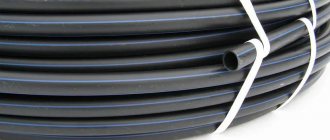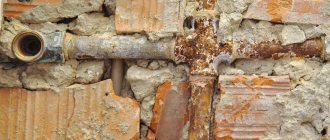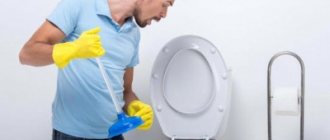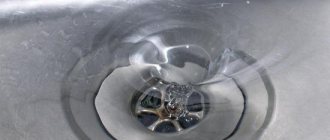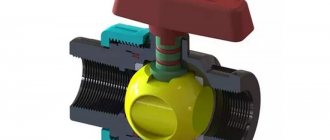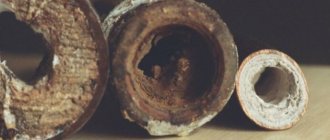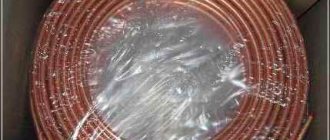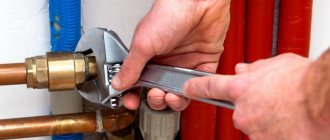The occurrence of rust on metal products during operation is an inevitable fact. This nuisance is formed as a result of the interaction of metal with oxygen, water, and various acids. A red-colored layer appears on the surface of the metal - a solid, insoluble substance that is very difficult to deal with.
And the point is not even that the metal has changed its color. The complexity of the situation lies in the fact that rust takes away a mass or volume of metal. In the case of pipes, this can lead to global problems - breaks and leaks.
Is it possible to restore the surface, remove rust, and how to treat the rust before painting the pipes, we will talk in this article.
Why does the problem of clogged pipes occur?
The long service life of the plumbing system leads to the fact that the pipe becomes clogged with rust, which falls off in layers from the walls of old pipes.
Even if plastic ones have already been laid, they are adjacent to a common cast-iron water supply system. With the flow of water, pieces of rust reach the apartment system. Over time, the surface of the plastic system becomes rough and deposits and salt impurities that are contained in the water accumulate on the walls. Poor water quality in the system causes a narrowing of the internal diameter of the pipes.
If the water pressure has only decreased slightly, but there are suspicions that this is due to rust, you should not delay cleaning the water supply. Otherwise, cleaning the water pipes later will be even more difficult, and the water in the tap will stop completely.
You need to start work by finding out where the blockage accumulates. A blockage forms both in the inside of water pipes and in the places where the faucet is installed, on filters installed for rough water purification, and in places where water consumption metering devices are connected. The second step after identifying the problem area will be its localization. This way you can clean a water pipe without complications.
When the pressure in the faucet is poor, there is a possibility of it breaking. The mixer structure is disassembled and cleaned. The long service life of the mixer, more than 5 years, is a reason to replace it.
In the water supply system, nets are installed to purify water from large debris in front of each device (washing machine, boiler, water consumption meters).
There is a possibility of finding a blockage in these places. Start by flushing out any mesh obstructions built into the plumbing system. If this does not help, then there is a blockage in the pipes. It is worth wondering how to clean a water pipe at home.
Water supply areas most susceptible to clogging
In order for cleaning water pipes to give the desired result and take less time and effort, you need to know about the likely places of blockage.
Let's consider the places in the water supply system that are most susceptible to clogging (located according to the greatest likelihood of a problem):
- Taps and mixers are the most vulnerable parts of the system, because even their most advanced design is not able to remove scale, rust, and dirt that accumulate on the internal parts of the equipment.
It is recommended to replace taps and mixers every 5-6 years. This will eliminate possible problems with the equipment and bring a fresh touch to the interior.
- Mesh filters located in spouts very often become clogged with scale, sand, etc. In this case, it is enough to unscrew the nut at the end of the spout and rinse the filter with running water.
- Strainers and water meter adapters also become clogged with scale, salts and other solid insoluble particles. To clean the filters, you need to remove them and rinse them with water; if the blockage is in the meter structure itself, you will have to partially disassemble it.
- Rectangular and other bends are also subject to clogging. This is the most difficult case, requiring drastic measures. Most often, bends in steel pipes become clogged.
This is what an old water pipe may look like, completely clogged after many years of use.
Causes of clogged water pipes
The causes of clogged water pipes can be:
- long-term operation without repairs and maintenance;
- errors in the installation of the pipeline system;
- failure of mixers and shut-off valves;
- poor quality of the supplied water, which may contain slag, sand, scale, rust, and insoluble salts.
Old plumbing very often causes blockages and poor quality water supply.
If the old water supply is clogged, then it is best to completely replace it, since the first clog may be followed by another. In addition, old pipes may begin to deteriorate. Modern pipes are resistant to corrosion, aesthetically pleasing and more reliable in operation.
Cleaning pipes from rust outside and inside
The working condition of the transport system is necessary for high-quality water supply. Reducing the diameter of the ducts reduces the pressure. Mechanical particles create characteristic noises and disrupt the functionality of taps. Brown impurities worsen the appearance of drinks. Timely cleaning of pipes from rust from the outside and from the inside will eliminate the listed shortcomings.
Description of problems, control operations
The cause of blockages in this category is corrosion. The most common option is the oxidation of products made from steel. In some cases, installers make a mistake by connecting aluminum and copper elements without an adapter device. The formed galvanic couple provokes the electrochemical destruction of metals.
Blockages in public highways are removed by city service organizations. Restoration of common building engineering structures is carried out by decision of a meeting of residents. In your own apartment, you can clean pipes from rust yourself.
To determine the scope of work, a preliminary survey is necessary. It should be understood that rust accumulates in fittings, taps, radiators, and other functional components. The high efficiency of the procedure is ensured by comprehensive cleaning. Additional difficulties arise when you have an individual boiler. You have to carefully remove contaminants from the heat exchanger, air vent, and circulation pump.
During the study, it is necessary to make sure that the decrease in pressure is not caused by a clogged main filter. If necessary, wash the mesh of this protective device.
In an old property, the feasibility of completely or partially replacing the transport part of the water supply system should be considered. Instead of rusting steel pipes, copper, profile, polymer or composite pipes are used. Such work involves opening the concrete screed, so it is carried out as part of a major overhaul.
Methods for cleaning water pipes
If the least labor-intensive methods (cleaning filters, disassembling the mixer) do not help restore the water supply, then you will have to resort to more radical measures. Which one to choose and how to clean the water pipe in your home is up to the owner to decide, but there are practical recommendations on this issue. Let's study the most common methods of cleaning water pipes.
The easiest way to remove a traffic jam
- The strainer is removed from the system.
- The tap opens to full supply of cold water. Using a hammer, slowly and carefully tap along the entire length of the pipes.
- Under the pressure of water, all debris will be washed out of the pipeline.
Cleaning a water pipe using a cable
There are special plumbing cables made of elastic steel. With their help, you can radically solve the problem of blockages in metal pipes clogged with scale. The cable has a handle, which you can rotate to clean inside the line. At the same time, the bends can be easily passed by the cable due to its design.
Cleaning water pipes is carried out in the following sequence:
- the water in the pipeline is blocked;
- taps or mixers are unscrewed;
- a cable is inserted into the clogged pipe;
- By rotating the handle, the cable is advanced along the line. As it moves, the cable destroys deposits on the internal walls of the water pipeline;
- Periodically it is necessary to turn on full water pressure, which will wash away all the dirt from the pipes.
It should be noted that this cleaning method is unacceptable for plastic pipes in which deposits do not form.
Using a plunger
A plunger is a device in the form of a rubber cap and a handle made of wood or plastic. Cleaning a water pipe using it will only be effective if the blockage is a short distance from the drain hole. A plunger is used to remove a small plug; it cannot cope with a large accumulation.
- The plunger is pressed tightly against the walls of the drain hole.
- The hand makes movements of pressing the plunger down and lifting it up, which forces the air to move. Under the influence of hydraulic power, small particles that have accumulated in one place begin to move further through the system and, together with water, merge into the hole.
There are more advanced models of the plunger - a pneumatic gun. It works on the same principle as a regular one, but the air is supplied with greater force.
Cleaning the water supply with dismantling the pipe
If cleaning with a cable does not give anything, then there is a more labor-intensive way to restore normal water flow. To do this, you need to partially dismantle the pipes and clean the clogged areas.
Of course, radically solving the problem in this way is very problematic. Moreover, other sections of the pipes may subsequently become clogged. So it is better to replace them with new products.
How to clean pipes in the bathroom or kitchen? The metal sections are connected by hollow corners with threads. Therefore, disassembly is carried out by unscrewing straight sections of pipes from such corners using two gas wrenches. Disconnected pipes are cleaned with strong pressure of hot water or by mechanical cleaning with a cable. After cleaning, the system elements are connected in the reverse order.
The blockage breaks through in the apartment under water pressure
It is easier to clear a clog in a cold water pipe. It has less water supply pressure than a hot water pipe.
- Close the spout thoroughly with your finger.
- Both taps open simultaneously: cold water and hot water.
- A stream of hot water will run into the cold water pipe. The pressure will break through the blockage.
- The debris will be squeezed into the sink. Sometimes the procedure has to be repeated several times.
Chemical cleaning of water pipes
There are commercially available chemicals that can be used to clean
plumbing system without having to disassemble it.
How to clean water pipes with chemicals? The product is simply poured into the water supply system. After a certain time, the system is flushed with a large amount of running water. The properties of the reagents that are used as chemical cleaning agents are such that they dissolve only deposits formed on the pipe walls. They do not affect metal, polypropylene, galvanized or metal-plastic.
Chemical cleaning is especially effective in private homes, since in high-rise buildings it is very difficult to circulate the reagent through the system.
Ultrasound
Ultrasonic waves have a destructive effect on any deposits. They remove scale more effectively than chemical reagents. Under the influence of devices, re-deposition of calcium salts is prevented. Ultrasound causes structural changes in chemical compounds in a liquid.
If apartment residents do not rely on their own strength to carry out plumbing work, it is better for them to contact a special service. There are companies in every city that clean water pipes and sewer lines.
Effective methods for external cleaning
It is not difficult to clean the surface from the outside. There are four rust removal methods to work with:
- Mechanically. Sandpaper and special attachments for power tools are suitable. Corrosion will be eliminated, after which washing and protection with a primer (paint) is required. Painting over rust is prohibited. Only after mechanical cleaning. Otherwise, high humidity (water passes under pressure through small pores and joints) will destroy any pipe in a short time.
- You can't do without using acid. Mix household ingredients (vinegar and citric acid) in different proportions. We apply the composition. In 2-3 hours there will be no trace of the raid. But for convenience, it is better to first go through step 1.
- Alkaline cleaning is carried out. Classic soda in the amount of 3 tablespoons dissolves in water. Apply to rust, then remove with vinegar. But soda will only work on a thin layer of rust; thick parts, again, are best cleaned with a tool with an attachment. It's faster that way.
- Using special chemicals (not for household use). We are talking about industrial compounds or concentrates.
Any method makes sense if you properly protect the outer surface after cleaning the surfaces with abrasives, for example. After all, steel, cleaned from the outside, will oxidize again after some time.
Let's see how to fix this below.
Cleaning away limestone deposits
To ensure that risers do not deteriorate from the inside, are used for a long time, do not reduce thermal conductivity, and also have an attractive appearance, it is necessary to regularly clean them of limestone deposits.
Mechanical and chemical cleaning are considered not very effective, since during their implementation the surface metal layer is destroyed. Plus, during such cleanings it is sometimes necessary to dismantle the system, which is not always pleasant, and from a financial point of view it is not very profitable. In addition, if you use chemical cleaning, you should strictly follow the instructions. Otherwise, you can not only harm yourself, but also harm the environment. Although, many people prefer these methods of protection against scale.
To carry out automated cleaning of pipes from rust and limestone deposits, use:
Compressor for purging
- compressor;
- automatic pump;
- high pressure devices.
With the help of a water or air jet supplied by these mechanisms under high pressure, limestone deposits are torn off the internal surfaces of the pipes and come out.
Using even the best methods and methods for removing scale in pipes, some of the metal is removed along with pieces of plaque. Therefore, it is better to prevent clogging of structures, for which it is necessary to regularly carry out preventive measures in order to eliminate the possibility of scale formation.
Important! The cost of preventative work to prevent the formation of limestone deposits is much cheaper than the process of cleaning a contaminated pipeline system.
We remove scale from plastic and copper pipes
Nowadays, copper and plastic pipes are the most common structures that are used both in apartments and in private premises. Copper analogs are used in heating, gas supply, and air conditioning systems. Plastic risers are used in water supply, sewer, and other mains. During operation, all risers, regardless of the material of manufacture, become covered with limescale. So, how to clean copper and plastic pipes from scale?
Both types of pipelines have their own advantages and disadvantages. But what they have in common is the impact of working environments in the form of precipitation, which must be periodically disposed of.
Therefore, scale in copper and plastic pipes and its cleaning is a serious problem for this equipment.
It should be remembered that reagents and devices that can be used to clean sediment from copper pipelines cannot be used to remove contaminants from plastic pipes. For example, chemical cleaning with acids is suitable for copper products. But if you use the same reagents to clean risers from other materials, then plastic, for example, may simply melt. Therefore, before starting the procedure for ridding pipes of contamination, you should correctly decide on the choice of mixtures, tools, and devices.
Getting rid of plaque using ultrasound
An ignorant person may think that ultrasonic descaling of pipes is a joke or a prank. How can ultrasound affect scale? But don't rush to conclusions. First things first.
It turns out that ultrasound not only softens water better than any reagents, but also cleans pipes of scale. How is scale practically removed using ultrasound?
The main advantage of the ultrasonic method is that after removing scale from pipes, they are no longer deposited on the inner surface of the pipe.
With the help of ultrasound, exposure is carried out in several ways simultaneously:
1. Salts are destroyed throughout the entire thickness of the water and it is purified, which eliminates the possibility of deposits on the walls. After all, it is known that scale forms when hard water comes into contact with a hard surface. It is on this property that the action of ultrasound is based, under the influence of which many crystallization centers begin to form throughout the entire water column. Since suspended particles have a larger area compared to the areas of warm surfaces, scale formation begins to occur as a result.
Under the influence of ultrasound, hardness salts split and their structural changes begin to occur. After this procedure, the size of salt crystals decreases by about 10 times. As a result, the surface area of all hardness salts increases by the same amount. Thanks to the presence of these small particles (their size is about 1 micron!), crystallization centers begin to be created throughout the water column, but they do not stick to the pipes! You can’t say anything: smart, simple, reliable!
2. Hard water is also subjected to a second exposure to ultrasonic waves. The essence of this process: high-frequency ultrasonic vibrations are created in metal surfaces. Thanks to this property, the entire heating surface is subject to these vibrations, and at the same time, repels hardness salts from the inner surface of the pipe. Since the hardness of the sediment and metal layers is different, ultrasonic vibrations passing through the heat-heating surface contribute to the gradual removal of old scale in the pipes. Thus, under the influence of ultrasonic waves, scale peeling is observed, pieces of which begin to be washed out of the equipment.
Cleaning with hydrochloric and citric acid
High-quality chemical cleaning of water and other pipes requires the presence of strong chemical reagents or products with components that must be properly diluted with water and poured into the pipe. Such mixtures can destroy any scale.
Hydrochloric acid is a very strong reagent. It is necessary to clean steel or cast iron risers with its help very carefully, since such a chemical descaling agent can greatly harm old pipeline structures. There have been cases where, as a result of a chemical reaction, through holes were formed in the iron.
When using hydrochloric acid to descale pipes, one should not forget to comply with safety regulations. Before starting work, you need to make sure that the room is well ventilated. After all, not only acid fumes are dangerous, but also gases that will be released during operation. Also, it is necessary to protect your eyes, hands, and respiratory organs from the possible influence of the chemical substance.
Work should begin with a solution of 5-10% concentration. If you do not achieve the desired result, you should increase the amount of acid.
Important! It is not recommended to use a hydrochloric acid solution with a concentration greater than 33-35%, otherwise the pipes may be damaged. The end of the washing process, which can last 3-4 hours, is indicated by the absence of foam. The used solution should be poured into an unnecessary container, neutralized with lime and poured in small portions in a remote, remote corner where no one walks.
Important! After chemical cleaning of pipes, you need to rinse them with plenty of water until you are sure that the chemicals are completely washed away. In terms of its popularity and effectiveness, citric acid is almost in no way inferior to hydrochloric acid. It is used to clean pipes from scale both in industry and at home.
But such a reagent should be used with some restrictions:
- it is necessary to take into account that the solution should be prepared in the following ratio: one percent per millimeter of limestone plaque;
- When working with a descaling agent such as citric acid, you should not use enamel and aluminum cookware, as you can be poisoned by harmful substances that will be formed after a possible chemical reaction.
Important! The concentration of citric acid solution should be in the range from 3 to 10%. A composition with a higher reagent capacity can burn through not only the formed scale, but also the surface of the pipe. Plus, cleaning pipes from scale with citric acid does not involve the use of solutions less than 3% concentration, since such a mixture can only partially dissolve the scale.
Requirements for paint and varnish material
Before you start choosing paint for heating pipes, you need to decide what functions the coating should perform. The main task is, of course, to protect the metal from external corrosion. Recently, in order to give the elements of the heating system a decorative appearance, even plastic pipelines and heating devices already coated with a protective layer have been painted. In this case, you can use paint without anti-corrosion properties.
Before painting central heating pipes in an apartment, it is necessary to take into account such an important factor as smell. It doesn't just refer to unpleasant sensations during work. A strong, persistent aroma indicates the presence of toxic substances in the material and can be dangerous to human health in high concentrations. Due to the fact that it is difficult to ensure ideal room ventilation, it is worth giving preference to odorless paints.
To ensure that the applied coating does not fade or crack over time, it is necessary to take into account the operating conditions. Since the temperature in the heating system is elevated and usually fluctuates between 40 and 80 ° C, the paint must be resistant to such heat. For periodic cleaning of pipes from dust and other household contaminants, resistance to abrasion and aggressive environments is important.
Based on the above, paint for heating pipes should have the following properties:
- ability to withstand temperature changes and heating up to 90 °C;
- abrasion resistance;
- resistance to aggressive environments;
- good adhesion to the appropriate substrate;
- Possibility of application directly onto rust;
- odor and safety for human health;
- suitable color scheme.
How to clean plastic drain pipes?
The question of how to clean plastic pipes is the most pressing, because now plastic plumbing is very popular. Plastic pipes have a smooth inner surface that is not subject to corrosion . Therefore, such products rarely become clogged. If deposits occur, they occur exclusively in the drainage system. Typically, fatty deposits and hair accumulate on the walls of pipes. They gradually clog the wastewater passage, which forces them to be removed.
Chemical or mechanical means can be used to clean drain pipes. Usually it is possible to do without disassembling the entire drain system. As mentioned, a plumbing cable works well. Excellent results are obtained by using chemicals that are simply poured into the sink or bathtub. After a certain time, the system is flushed with water.
For internal
All methods to prevent plaque and eliminate it strictly from the inside of metal pipes. Let's consider those cases when the steel system has already worked for some time.
Water hammer
It is optimally suited, since there is no need to disassemble the rusted system.
The idea is simple - air with sand (or other abrasive material) is supplied under pressure into rusty pipes. There are hand sandblasters, but they are not suitable for cleaning such products. Be careful.
Plaque removers. A primitive, but quite effective way for independent work. It is recommended to use plumbing flushing for prevention specifically in the water supply system. But you can independently supply rust converters to the heating system only in a private modern house.
It is better to give preference to inexpensive types of chemicals. And remember that all these compounds can get into the surrounding living environment. When pumping out a septic tank, this should be taken into account.
With abrasive everything is simple, because it is an analogue of sandblasting. Only air is replaced by liquid during the cleaning process. The abrasive cleaning system is expensive, complex, and is performed by highly specialized craftsmen. It is necessary to create increased pressure in the system in several approaches and pump out the rust. Therefore, a preliminary assessment of the condition of the pipes is mandatory.
We conclude that it is easier to remove internal corrosion systematically using chemistry. Heating systems are most often flushed by household utilities.
Preventing blockages in water supply pipes
When studying the question of how to clean water pipes at home, one cannot fail to mention preventive measures against intra-pipe deposits. The use of a primary filter is the most common and effective of them. In common use it is known as a coarse filter.
Externally, this device looks like an ordinary mesh designed to retain large debris. The plumbing system can be equipped with several devices of this type. Apartments in modern high-rise buildings usually have similar filters in front of all meters, for which special cork flanges are used.
The cylindrical mesh is removed after unscrewing the plug on such a flange: sometimes it is so clogged with debris that it must be cleaned with a nail or screwdriver. Stainless steel is used to make the mesh: it is not susceptible to corrosion, but the accumulation of rust on it can be so dense that it leads to clogging of all holes. A good cleaning method is concentrated acid: it can remove all deposits from the mesh in a short time without causing any damage to it.
Keeping pipelines clean is the key to the health of all inhabitants of the house. In addition, this makes it possible to significantly extend the life of household appliances.
How to avoid blockages
- In the first place among the necessary means and methods of dealing with blockages is the use of a coarse filter. It looks like a mesh barrier for large pieces of rust. It is recommended to install several barriers in the system.
Plumbers recommend installing a flask with a filter in front of the water meter. The mesh becomes clogged to such an extent that it can only be cleared with a nail or a screwdriver. The filter mesh is made of stainless steel and is not characterized by corrosive phenomena. But rust from the pipes can settle tightly on the walls of the filter and completely block the passage of water.
To quickly clean the mesh, it is recommended to treat it with hydrochloric acid for a few minutes.
- Prevention measures are being taken using folk remedies. In the fight against water supply blockages, such measures are considered ineffective; they are used only to prevent problems from occurring.
